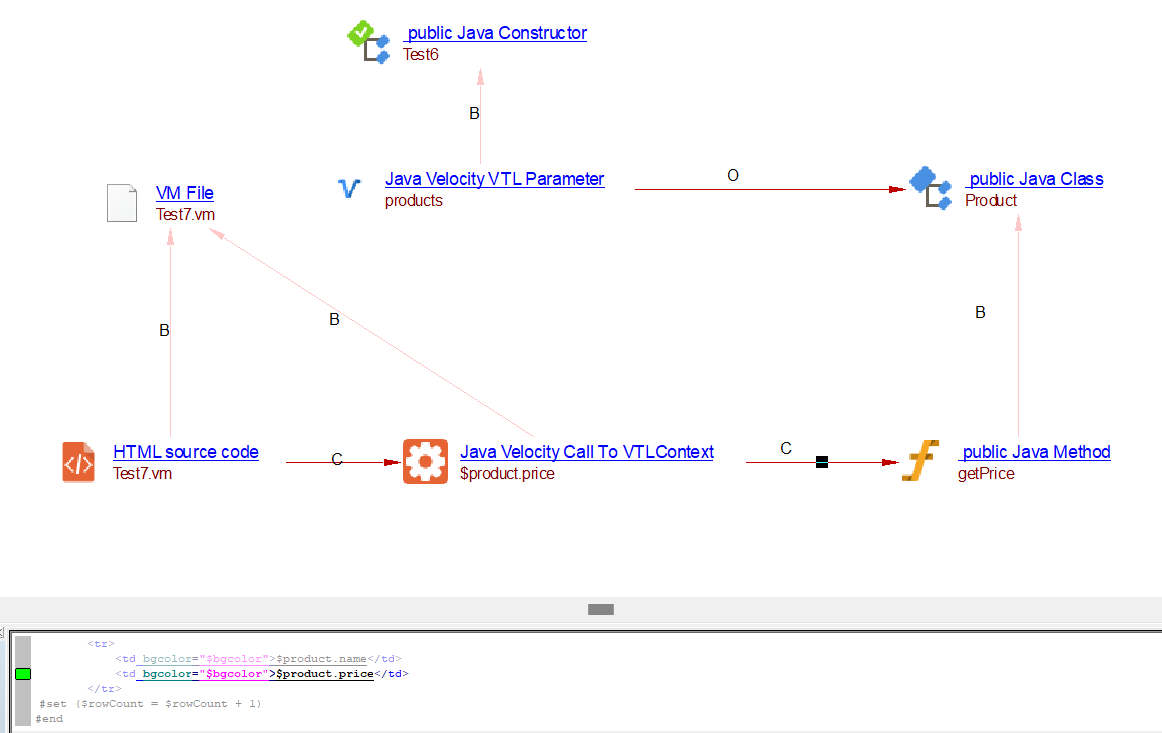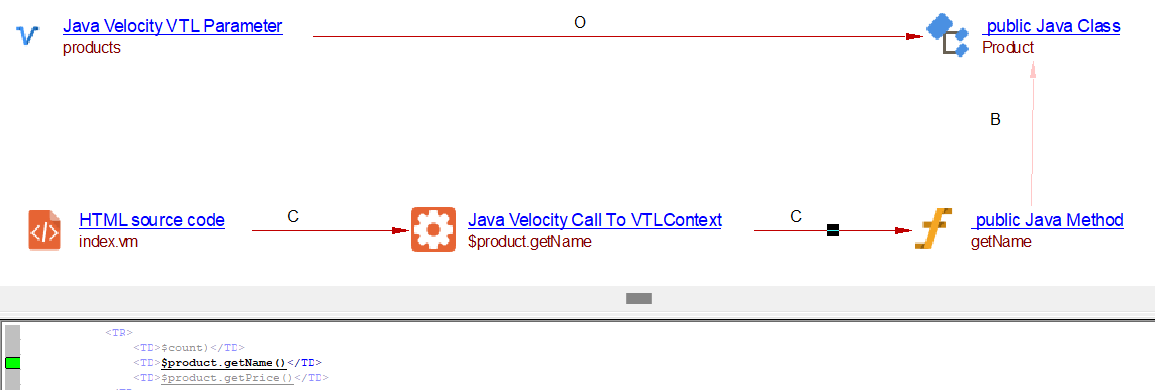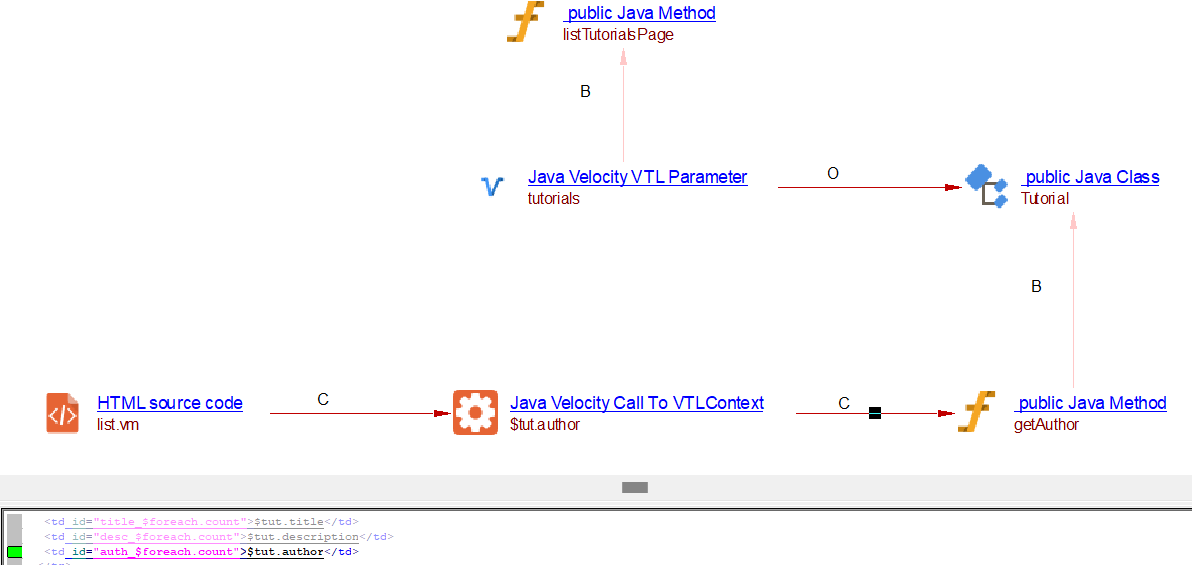Apache Velocity - 1.0
Extension Id
com.castsoftware.java.velocity
What’s new?
Please see Apache Velocity - 1.0 - Release Notes for more information.
Description
This extension provides support for Apache Velocity Framework. Apache Velocity is a Java-based templating engine, used to create dynamic web pages by parsing data model to template.
In what situation should you install this extension?
If your Java application uses the Apache Velocity Framework.
Technology support
| Component | Version | Supported | Supported Technology |
|---|---|---|---|
| velocity-engine-core | 2.x | ✔️ | JAVA |
| velocity-tools-view | 3.x | ✔️ | JAVA |
| spring-velocity-support | 2.x | ✔️ | JAVA |
| spring-context-support | <= 4.3.x | ✔️ | JAVA |
| spring-webmvc | <= 4.3.x | ✔️ | JAVA |
| spring-context | <= 4.3.x | ✔️ | JAVA |
AIP Core compatibility
This extension is compatible with:
| AIP Core release | Supported |
|---|---|
| 8.3.x | ✔️ |
Download and installation instructions
The extension will not be automatically downloaded and installed in CAST Console. If you need to use it, you should manually install the extension using the Application - Extensions interface.
What results can you expect?
Objects
| Icon | Description |
|---|---|
 |
Java Velocity VTL Parameter |
 |
Java Velocity Call To VTLContext |
Links
| Link Type | Source and destination of link | Supported Velocity Engine Core Methods |
|---|---|---|
| relyonLink | Between Java Velocity VTL Parameter and respective Context JAVA class. | Velocity Engineorg.apache.velocity.app.Velocity.mergeTemplateorg.apache.velocity.app.VelocityEngine.mergeTemplate org.apache.velocity.Template.merge Velocity Toolsorg.apache.velocity.tools.view.VelocityViewServlet.mergeTemplateorg.apache.velocity.tools.view.VelocityLayoutServlet.mergeTemplate org.apache.velocity.tools.view.VelocityView.merge Velocity Springorg.springframework.ui.velocity.VelocityEngineUtils.mergeTemplateIntoStringorg.springframework.ui.velocity.VelocityEngineUtils.mergeTemplate org.apache.velocity.spring.VelocityEngineUtils.mergeTemplateIntoString org.apache.velocity.spring.VelocityEngineUtils.mergeTemplate org.springframework.web.servlet.view.velocity.VelocityView.mergeTemplate |
| relyonLink | Between Java Velocity VTL Parameter and respective Context JAVA class. | org.apache.velocity.tools.view.VelocityViewServlet.getTemplate org.apache.velocity.app.Velocity.getTemplate org.apache.velocity.app.VelocityEngine.getTemplate org.apache.velocity.tools.view.VelocityView.getTemplate org.apache.velocity.context.Context.put org.apache.velocity.VelocityContext.put org.apache.velocity.context.AbstractContext.put NOTE: Java Velocity VTL Parameter object is created, only if the above APIs are called from overridden handleRequest method of VelocityViewServlet/VelocityLayoutServlet derived class. |
| relyonLink | Between Java Velocity VTL Parameter and respective Context JAVA class. | Model Attributeorg.springframework.ui.Model.addAttributeorg.springframework.ui.ModelMap.addAttribute Velocity Configurationorg.apache.velocity.spring.VelocityEngineFactory.VelocityEngineFactoryorg.apache.velocity.spring.VelocityEngineFactory.setResourceLoaderPath org.apache.velocity.spring.VelocityEngineFactory.setResourceLoader org.apache.velocity.spring.VelocityEngineFactoryBean.VelocityEngineFactoryBean org.springframework.ui.velocity.VelocityEngineFactory.VelocityEngineFactory org.springframework.ui.velocity.VelocityEngineFactory.setResourceLoaderPath org.springframework.ui.velocity.VelocityEngineFactory.setResourceLoader org.springframework.ui.velocity.VelocityEngineFactoryBean.VelocityEngineFactoryBean org.springframework.web.servlet.view.velocity.VelocityConfigurer.VelocityConfigurer org.springframework.web.servlet.view.velocity.VelocityConfigurer.setVelocityEngine org.springframework.web.servlet.view.velocity.VelocityView.setVelocityEngine Velocity View and Resolverorg.springframework.web.servlet.view.velocity.VelocityLayoutViewResolver.VelocityLayoutViewResolverorg.springframework.web.servlet.view.velocity.VelocityLayoutViewResolver.setLayoutUrl org.springframework.web.servlet.view.velocity.VelocityViewResolver.VelocityViewResolver org.springframework.web.servlet.view.velocity.VelocityViewResolver.setToolboxConfigLocation org.springframework.web.servlet.view.velocity.VelocityToolboxView.VelocityToolboxView org.springframework.web.servlet.view.velocity.VelocityToolboxView.setToolboxConfigLocation NOTE: Java Velocity VTL Parameter object will be created, if the Model Attribute APIs are called from Spring Controller methods which returns template name string and Velocity Config is defined using above mentioned Velocity Configuration, View and Resolver APIs, either using Java Config or XML Config Methods |
| callLink | Between HTML source code objects and Java Velocity Call To VTLContext objects. | |
| callLink | Between Java Velocity Call To VTLContext objects and JAVA methods. |
Code Examples
Velocity Engine Core
Velocity Engine code - Test6.java
package test.velocity;
import org.apache.velocity.app.Velocity;
import org.apache.velocity.Template;
import org.apache.velocity.VelocityContext;
import org.apache.velocity.context.Context;
import java.io.Writer;
import java.io.StringWriter;
import java.util.ArrayList;
import java.util.Collection;
import bean.Product;
class Test6 {
public Test6() throws Exception {
Velocity.init("src/main/java/velocity.properties");
Context context = new VelocityContext();
final Collection<Product> products = new ArrayList<>();
//context.put("test", "test");
products.add(new Product("Widget", 12.99));
products.add(new Product("Wotsit", 13.99));
products.add(new Product("Thingy", 11.99));
context.put("products", products);
Template template2 = Velocity.getTemplate("Test7.vm");
Writer writer2 = new StringWriter();
template2.merge(context, writer2);
System.out.println(writer2.toString());
}
}
Context Class - product.java
package bean;
public class Product {
private String name;
private double price;
public Product(String aName, double aPrice) {
name = aName;
price = aPrice;
}
public String getName() {
return name;
}
public double getPrice() {
return price;
}
public void setName(String val) {
name = val;
}
public void setPrice(double val) {
price = val;
}
public String getNameAndPrice() {
return "Name: " + getName() + " Price: " + getPrice();
}
}
Velocity Template - Test7.vm
#macro (writeTable $productList)
#set ($rowCount = 1)
#foreach($product in $productList)
#if ($rowCount % 2 == 0)
#set ($bgcolor = "#FFFFFF")
#else
#set ($bgcolor = "#CCCCCC")
#end
<tr>
<td bgcolor="$bgcolor">$product.name</td>
<td bgcolor="$bgcolor">$product.price</td>
</tr>
#set ($rowCount = $rowCount + 1)
#end
#end
<html>
<head>
<title>Macros Test</title>
</head>
<body>
<table>
#writeTable($products)
</table>
</body>
</html>

Velocity Tools View
VelocityViewServlet - ProductServlet.java
package com.test.apache.velocity.servlet;
import com.test.apache.velocity.model.Product;
import com.test.apache.velocity.service.ProductService;
import org.apache.velocity.Template;
import org.apache.velocity.context.Context;
import org.apache.velocity.tools.view.VelocityViewServlet;
import org.slf4j.Logger;
import org.slf4j.LoggerFactory;
import javax.servlet.http.HttpServletRequest;
import javax.servlet.http.HttpServletResponse;
import java.util.List;
public class ProductServlet extends VelocityViewServlet {
ProductService service = new ProductService();
@Override
public Template handleRequest(HttpServletRequest request, HttpServletResponse response, Context context) {
Logger logger= LoggerFactory.getLogger(ProductServlet.class);
List<Product> products = service.getProducts();
context.put("products", products);
Template template = null;
try {
template = getTemplate("templates/index.vm");
response.setHeader("Template Returned", "Success");
} catch (Exception e) {
logger.error("Error while reading the template ", e);
}
return template;
}
}
Context Class - Product.java
package com.test.apache.velocity.model;
public class Product {
private String name;
private double price;
public Product(String name, double price) {
this.name = name;
this.price = price;
}
public String getName() {
return name;
}
public void setName(String name) {
this.name = name;
}
public double getPrice() {
return price;
}
public void setPrice(double price) {
this.price = price;
}
@Override
public String toString() {
return "Product{" + "name='" + name + '\'' + ", price=" + price + '}';
}
}
Velocity Template - index.vm
<HTML>
<HEAD>
<TITLE>Online Electronic Store</TITLE>
<style>
body {background-color: powderblue;}
h1 {color: blue;}
p {color: red;}
table.gridtable {
font-family: verdana,arial,sans-serif;
font-size:11px;
color:#333333;
border-width: 1px;
border-color: #666666;
border-collapse: collapse;
}
table.gridtable th {
border-width: 1px;
padding: 8px;
border-style: solid;
border-color: #666666;
background-color: #dedede;
}
table.gridtable td {
border-width: 1px;
padding: 8px;
border-style: solid;
border-color: #666666;
background-color: #ffffff;
}
</style>
</HEAD>
<BODY>
<CENTER>
<h1>Today's Offers</h1>
<BR/>
<BR/>
<h2>$products.size() Products on Sale!</h2>
<BR/>
We are proud to offer these fine products
at these amazing prices.
<BR/>
<BR/>
#set( $count = 1 )
<TABLE class="gridtable">
<TR>
<TH>Serial #</TH><TH>Product Name</TH><TH>Price</TH>
</TR>
#foreach( $product in $products )
<TR>
<TD>$count()</TD>
<TD>$product.getName()</TD>
<TD>$product.getPrice()</TD>
</TR>
#set( $count = $count + 1 )
#end
</TABLE>
<BR/>
</CENTER>
</BODY>
</HTML>

Velocity Spring
Velocity Java Config - WebConfig.java
package com.baeldung.mvc.velocity.spring.config;
import org.springframework.context.annotation.Bean;
import org.springframework.context.annotation.ComponentScan;
import org.springframework.context.annotation.Configuration;
import org.springframework.web.servlet.ViewResolver;
import org.springframework.web.servlet.config.annotation.DefaultServletHandlerConfigurer;
import org.springframework.web.servlet.config.annotation.EnableWebMvc;
import org.springframework.web.servlet.config.annotation.ResourceHandlerRegistry;
import org.springframework.web.servlet.config.annotation.WebMvcConfigurerAdapter;
import org.springframework.web.servlet.view.velocity.VelocityConfigurer;
import org.springframework.web.servlet.view.velocity.VelocityLayoutViewResolver;
@Configuration
@EnableWebMvc
@ComponentScan(basePackages = { "com.baeldung.mvc.velocity.controller", "com.baeldung.mvc.velocity.service" })
public class WebConfig extends WebMvcConfigurerAdapter {
@Override
public void addResourceHandlers(ResourceHandlerRegistry registry) {
registry.addResourceHandler("/resources/**").addResourceLocations("/resources/");
}
@Override
public void configureDefaultServletHandling(DefaultServletHandlerConfigurer configurer) {
configurer.enable();
}
@Bean
public ViewResolver viewResolver() {
final VelocityLayoutViewResolver bean = new VelocityLayoutViewResolver();
bean.setCache(true);
bean.setPrefix("/WEB-INF/views/");
bean.setLayoutUrl("/WEB-INF/layouts/layout.vm");
bean.setSuffix(".vm");
return bean;
}
@Bean
public VelocityConfigurer velocityConfig() {
VelocityConfigurer velocityConfigurer = new VelocityConfigurer();
velocityConfigurer.setResourceLoaderPath("/");
return velocityConfigurer;
}
}
Velocity XML Config - mvc-servlet.xml
<?xml version="1.0" encoding="UTF-8"?>
<beans xmlns="http://www.springframework.org/schema/beans"
xmlns:xsi="http://www.w3.org/2001/XMLSchema-instance"
xmlns:context="http://www.springframework.org/schema/context"
xsi:schemaLocation="http://www.springframework.org/schema/beans
http://www.springframework.org/schema/beans/spring-beans.xsd
http://www.springframework.org/schema/context
http://www.springframework.org/schema/context/spring-context-4.1.xsd">
<!-- Register the annotated components in the container eg : annotated controllers -->
<context:component-scan base-package="com.baeldung.mvc.velocity.*"/>
<!-- Tell the container that we are going to use annotations -->
<context:annotation-config/>
<bean id="velocityConfig"
class="org.springframework.web.servlet.view.velocity.VelocityConfigurer">
<property name="resourceLoaderPath">
<value>/</value>
</property>
</bean>
<bean id="viewResolver"
class="org.springframework.web.servlet.view.velocity.VelocityLayoutViewResolver">
<property name="cache" value="true"/>
<property name="prefix" value="/WEB-INF/views/"/>
<property name="layoutUrl" value="/WEB-INF/layouts/layout.vm"/>
<property name="suffix" value=".vm"/>
</bean>
</beans>
Context Class - Tutorial.java
package com.baeldung.mvc.velocity.domain;
public class Tutorial {
private final Integer tutId;
private final String title;
private final String description;
private final String author;
public Tutorial(Integer tutId, String title, String description, String author) {
this.tutId = tutId;
this.title = title;
this.description = description;
this.author = author;
}
public Integer getTutId() {
return tutId;
}
public String getTitle() {
return title;
}
public String getDescription() {
return description;
}
public String getAuthor() {
return author;
}
}
Spring Controller Class - MainController.java
package com.baeldung.mvc.velocity.controller;
import com.baeldung.mvc.velocity.domain.Tutorial;
import com.baeldung.mvc.velocity.service.ITutorialsService;
import org.springframework.beans.factory.annotation.Autowired;
import org.springframework.stereotype.Controller;
import org.springframework.ui.Model;
import org.springframework.web.bind.annotation.RequestMapping;
import org.springframework.web.bind.annotation.RequestMethod;
import java.util.List;
@Controller
@RequestMapping("/")
public class MainController {
@Autowired
private ITutorialsService tutService;
@RequestMapping(value = "/", method = RequestMethod.GET)
public String welcomePage() {
return "index";
}
@RequestMapping(value = "/list", method = RequestMethod.GET)
public String listTutorialsPage(Model model) {
List<Tutorial> list = tutService.listTutorials();
model.addAttribute("tutorials", list);
return "list";
}
public ITutorialsService getTutService() {
return tutService;
}
public void setTutService(ITutorialsService tutService) {
this.tutService = tutService;
}
}
Velocity Template - list.vm
<h1>Index</h1>
<h2>Tutorials list</h2>
<table border="1">
<tr>
<th>Tutorial Id</th>
<th>Tutorial Title</th>
<th>Tutorial Description</th>
<th>Tutorial Author</th>
</tr>
#foreach($tut in $tutorials)
<tr>
<td id="tutId_$foreach.count">$tut.tutId</td>
<td id="title_$foreach.count">$tut.title</td>
<td id="desc_$foreach.count">$tut.description</td>
<td id="auth_$foreach.count">$tut.author</td>
</tr>
#end
</table>
